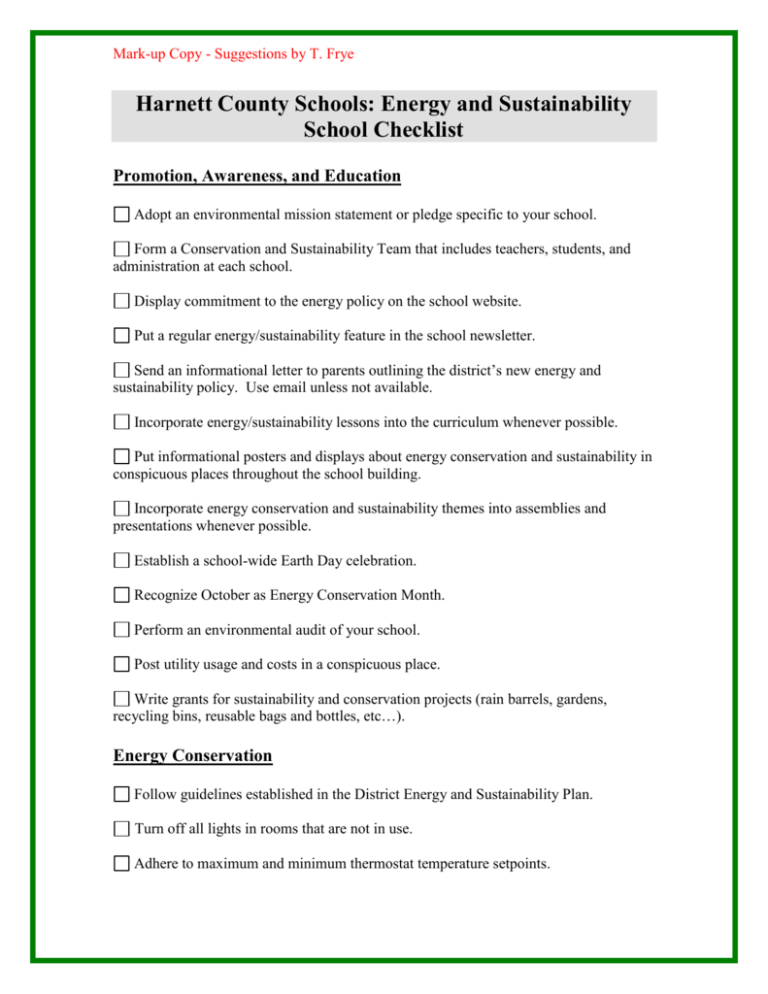Checklist_Suggestions_TSF
advertisement

Mark-up Copy - Suggestions by T. Frye Harnett County Schools: Energy and Sustainability School Checklist Promotion, Awareness, and Education Adopt an environmental mission statement or pledge specific to your school. Form a Conservation and Sustainability Team that includes teachers, students, and administration at each school. Display commitment to the energy policy on the school website. Put a regular energy/sustainability feature in the school newsletter. Send an informational letter to parents outlining the district’s new energy and sustainability policy. Use email unless not available. Incorporate energy/sustainability lessons into the curriculum whenever possible. Put informational posters and displays about energy conservation and sustainability in conspicuous places throughout the school building. Incorporate energy conservation and sustainability themes into assemblies and presentations whenever possible. Establish a school-wide Earth Day celebration. Recognize October as Energy Conservation Month. Perform an environmental audit of your school. Post utility usage and costs in a conspicuous place. Write grants for sustainability and conservation projects (rain barrels, gardens, recycling bins, reusable bags and bottles, etc…). Energy Conservation Follow guidelines established in the District Energy and Sustainability Plan. Turn off all lights in rooms that are not in use. Adhere to maximum and minimum thermostat temperature setpoints. Mark-up Copy - Suggestions by T. Frye Check time clocks, sensors, and controls on lighting and HVAC every season. Do not operate window air conditioning/heating units after hours. Evaluate school operation during the summer to determine potential utility savings and cutbacks. Replace all incandescent light bulbs with compact fluorescent (CFL) bulbs. Remove all unnecessary personal appliances (refrigerators, coffee makers, microwaves, etc…) from classrooms. Special permission must be granted for any personal applicance to be in use in a classroom. Do not block air supply and return vents with furniture or materials. Do not leave doors or windows open for extended periods of time. Program computer monitors to “sleep” after 15 minutes and CPUs to “sleep” after 1 hour. Identify and remove all unnecessary plug loads (unused cell phone or laptop chargers, televisions, DVD players, etc…) Utilize daylighting wherever possible. On bright days, turn off light banks closest to windows. When not in use, turn off large banks of lighting in cafeteria, gymnasium, media center, etc… Have custodial staff ensure that night time setbacks are working correctly during evening rounds. Report any mechanical equipment that appears to be making unusual amounts of noise or operating abnormally. Place “lights off” signs on or near light switches. Use natural ventilation wherever possible. Use task lighting after regular school hours. When possible, consolidate after-hours activities to the same area of the school building in order to prevent unnecessary lighting of unoccupied spaces. Delamp over-lit areas. Mark-up Copy - Suggestions by T. Frye Delamp vending machines Ensure that community appliances (refrigerators, microwaves, etc) are Energy Star appliances. . Unplug unused electronic equipment. Use plug strips that can be switched off to avoid drawing phantom power. Sustainability/Waste Reduction Follow guidelines established in the District Energy and Sustainability Plan. Recycle all possible waste (paper, plastic, metals, glass, cardboard, batteries, light bulbs, etc…). Train housekeeping staff to reuse trash can liners. Use electronic communication whenever possible to reduce paper waste. Use double-sided copying when printing is required. Place signs at printers and copiers encouraging double sided copying. Eliminate unnecessary magazine and junk mail subscriptions. When faxing, use a fax stamp or label instead of a cover sheet. Reuse packaging material such as boxes, wrapping material, etc… when possible. Reuse envelopes and file folders. Use excess or misprinted computer paper (containing no confidential information) as note paper. Purchase products made from recycled or biodegradable material whenever possible. Encourage faculty and students to bring reusable water bottles to school. Encourage faculty and students to bring lunches in reusable containers and bags. Purchase “green” cleaning products made with less toxic chemicals. Organize litter clean up days around the school grounds. Properly dispose of grease, cleaning products, and other chemicals. Mark-up Copy - Suggestions by T. Frye Place water conservation signs in restrooms and near water fountains. Report all leaking or broken water fixtures to the maintenance department. Establish “No-Idle Zones” in front of school building and educate the public of the purpose. Encourage bus ridership.








